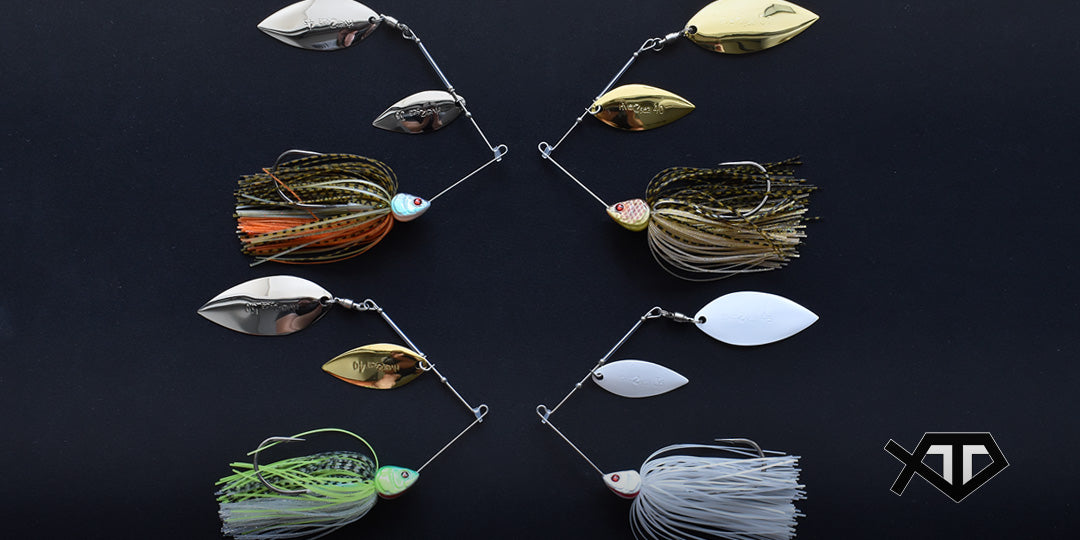In the world of bass fishing, spinnerbaits have become a go-to lure for many anglers. These versatile lures can be used in a variety of situations and are known for their ability to attract big bass. Whether you are a seasoned pro or just starting out, spinnerbait fishing is a technique that you should definitely have in your arsenal. In this article, we will cover everything you need to know about spinnerbait fishing, from the basics to advanced tips and techniques.
What is a spinnerbait?
Spinnerbaits are unique lures that consist of a lead/tungsten head, one or more spinning blades, a skirt made from rubber or silicone strands, and a hook. The spinning blades create flash and vibration in the water, mimicking the movement of a school of baitfish and triggering the reactive, predatory instincts in bass.
Where to use a spinnerbait?
When it comes to finding the best spots, there are a few key areas you should focus on. One of the most productive areas is around submerged structures such as fallen trees, brush piles, or rock formations. These structures provide cover and ambush points for bass.
Weed beds are another excellent spot to target with spinnerbaits. Bass often hide within the weeds, waiting to ambush their prey. Cast your lure along the edges of the weeds and retrieve it through the gaps, imitating a baitfish trying to escape.
Points and drop-offs are also worth exploring. These underwater structures act as natural highways for bass, allowing them to move between shallow and deep water. Spinnerbaits excel at covering water quickly, making them ideal for fishing these areas efficiently.
How to retrieve a spinnerbait?
Spinnerbaits can be fished in various depths depending on the water conditions and the behaviour of the bass. In shallow water, you can target bass near the surface as your retrieve speed will determine the depth at which it runs. This allows the blades to create a commotion on the water's surface, attracting the attention of nearby bass. In deeper water, you can let the spinnerbait sink to the desired depth and then retrieve it at a steady pace to imitate a swimming baitfish.
Another technique to consider when fishing with spinnerbaits is the "stop-and-go" retrieve. This involves periodically pausing the retrieve to let the spinnerbait fall and flutter, simulating a wounded or dying baitfish. This erratic action can trigger aggressive strikes from bass that are following the lure.
How to choose the right spinnerbait?
Choosing the right spinnerbait can be overwhelming due to the numerous options available. Here are a few factors to consider when making your selection:
Blade Style: Willowleaf (long & thin) blades create a lot of flash and are ideal for clear water, while Colorado (round & wide) blades produce more vibration and are suitable for murky conditions.
Blade Colour: Experiment with different blade colours to find out what the bass are most attracted to in your fishing area. Popular choices include silver, gold, and white.
Blade Thickness: Carefully evaluate the blade thickness as a thicker blade will require a higher speed before it spins appropriately and the inverse with a thin blade.
Skirt Colour: The colour of the skirt should match the natural prey found in the water. Green pumpkin, black, and chartreuse are common skirt colours that mimic baitfish or crawfish.
Lure Weight: The weight of the spinnerbait influences how deep it will sink and how quickly you can retrieve it. Choose a weight that allows you to fish at the desired depth and maintain control over the lure.
Tips and techniques
To make your spinnerbait fishing more productive, here are some additional tips and techniques to keep in mind:
- Experiment with different blade colours and styles. Bass can be picky, so it's essential to have a variety of options in your tackle box.
- If you are fishing in clear water, consider using a smaller spinnerbait with willowleaf blades. The slender profile and gentle blade movement can fool even the most cautious bass.
- Don't be afraid to experiment with different retrieve speeds and pauses. Sometimes a subtle change in presentation can make all the difference.
- Pay attention to the weather conditions. Bass are more likely to be active and feeding on spinnerbaits when the weather is overcast or there is a slight breeze.
Spinnerbait bass fishing is a thrilling and effective technique that can produce fantastic results. Whether you are a beginner or an experienced angler, mastering the art of spinnerbait fishing will open up a whole new world of angling opportunities. Remember to experiment with retrieve speeds, target the right areas, and choose the right spinnerbait for the conditions. With a bit of practice and patience, you'll soon find yourself reeling in more bass than ever before.
Looking for a different spinnerbait option that your fish would not have seen before? Explore our range of spinnerbaits.

